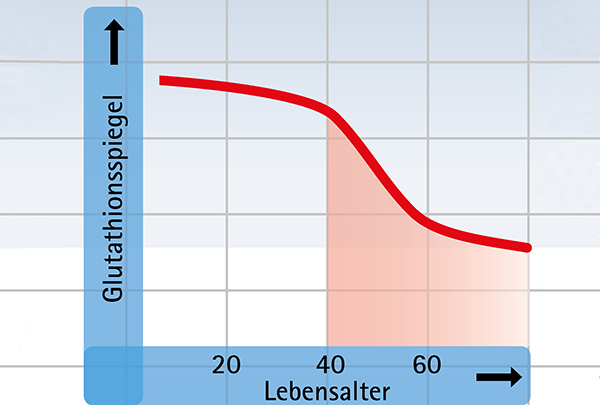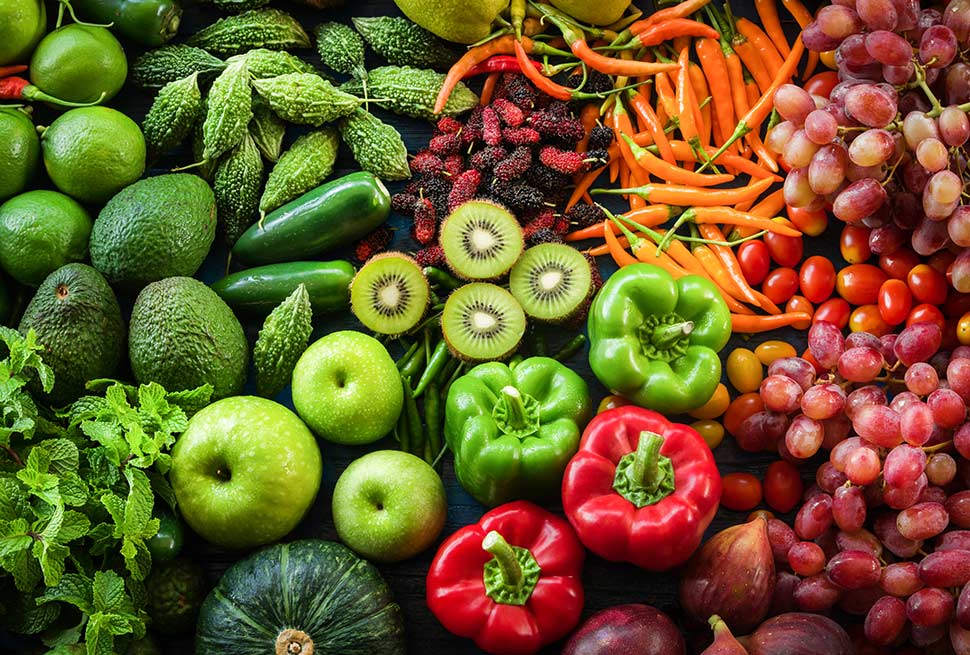What is Glutathione (GSH)?
Glutathione (GSH) is not a drug, but a naturally occurring endogenous substance that is present in every body cell and used by the organism to protect against chemical and environmental hazards. More than 60 years of research and tens of thousands of scientific papers have proven that glutathione is one of the most important protective molecules in the human body.
The versatile tasks of GSH in the body are among others: Neutralisation of toxic chemicals; maintenance of cell proteins to protect against metabolic disorders; strengthening of the immune system; effect as a powerful antioxidant; support of the maintenance of vitamin C and E status 1.
Sources of Glutathione
Glutathione is both supplied by food and produced by the body itself. All cells are able to produce GSH, with the liver producing the highest amounts as the central organ for detoxification. The best food source for glutathione is freshly prepared meat, poultry and fish, fresh fruit and vegetables (raw and cooked). In the USA, for example, the usual intake of glutathione ranges from 3 mg to almost 250 mg a day 2,3.
Many plant foods such as broccoli, Brussels sprouts, cauliflower, cabbage, onions and garlic can help to increase the ability to self-synthesize glutathione in the body 1,4.
Another sensible way to increase the GSH level is to use a high-quality dietary supplement with reduced glutathione.
With the exception of frozen foods, glutathione is largely destroyed in all other industrial food processing processes. Preserves, foods treated for a longer shelf life (e. g. cured, smoked etc.), dried foods, cereals and cereals, dairy products, sweeteners, spices and most juices (except orange juice) do not contain any significant amounts of GSH. Therefore, a diet with mainly processed and little fresh food is a risk factor with the consequence of a possible glutathione deficiency.
The protective role of GSH in the body
The highest concentration of glutathione is found in the liver and kidneys as well as in the intestine and in the lung tissue fluid, where GSH neutralizes toxic substances and inhaled pollutants absorbed through food or by environmental influences.
Furthermore, Glutathione is present in the mucous membranes of the entire gastrointestinal tract, where it can catch and neutralize toxins before they are absorbed by the organism.
Glutathione serves not only as a barrier in the lung tissue fluid, but also strengthens the effect of special immune cells, which form the body’s most important defence chain 1,5.
Glutathione acts as an antioxidant throughout the body and reacts to free radicals to neutralize them. GSH also supports the regeneration of vitamin C and E, two other important antioxidants in the body. In this way, glutathione not only directly prevents oxidative damage to cells, but also acts indirectly in the team by supporting other powerful antioxidants. 1 This protective function takes place permanently in all important organ systems – not only in the liver, kidneys, intestines and lungs, but also in the brain, heart, skeletal muscle, skin and the immune system.
Which factors have a negative influence on the Glutathione level?
Many factors influence the glutathione status. An inevitable factor is age. The glutathione status in humans usually starts to deteriorate at the age of about 45 and decreases very quickly after the age of 60 as self-synthesis decreases due to age 7,8 The loss of the protective function of GSH can then lead to an increase in oxidative stress, which in turn can lead to accelerated ageing.
A low glutathione status can be attributed to the following relationships, among others:
- Habits: e. g. smoking, excessive alcohol consumption, taking medicines or non-prescription
drugs 1,9,10,11 - Environmental factors: e. g. UV radiation, ionising radiation, oil vapours, saturated fats, environmental pollutants and chemicals 12
- Obesity/fat addiction: e. g. excess fat leads to oxidative stress in the body, which in turn can lead to the degradation of antioxidants 13,14
- Diseases: e. g. certain diseases such as diabetes type 2, cardiovascular diseases, cancer, kidney disease, Parkinson’s disease, lung disease and age-related eye diseases such as cataracts and macular degeneration can have a negative influence on the glutathione status 1,3,15,16,17,18
Whenever oxidative stress increases, e. g. in connection with increasing age, disease, lifestyle or environmental factors, glutathione can be consumed faster than it is produced in the body. This increase in oxidative stress can lead to premature aging.
There is interesting scientific evidence on the relationship between a good GSH status and good health: For example, the glutathione level of 41 centenarians aged between 100 and 106 years was compared with that of people aged between 60 and 79 years. It was found that the level of glutathione was significantly higher in the over-100 group than in the younger comparison group and that the highest level of glutathione was again found in the over-100 year olds with the best health status 20, and as a result of the study it was found that a high level of glutathione was causally linked to a high life expectancy.
The Important Role of Glutathione Dietary Supplements
If the body does not produce enough glutathione to meet the needs of the organism, an increased intake of food containing GSH and/or a dietary supplement with GSH may be advantageous. Clinical studies have shown that taking GSH in the form of a dietary supplement can increase glutathione levels in critical organs such as the lungs, intestines, kidneys, liver and blood plasma 21,22,23,24,25,26.
A healthy diet leads to a daily intake of about 250 milligrams of glutathione via the diet, but most people only consume about 50 to 60 mg of glutathione per day due to their dietary habits. For a nutritional supplement from a preventive point of view, 600mg daily should therefore be a reasonable guideline for healthy people to close this gap. Environmental influences, alcohol consumption, smoking, inflammation, infections, etc. can widen the gap, but a higher amount should be considered. There is no upper safety limit for taking glutathione supplements, but a high intake of 3000 milligrams per day has not had any negative effects.
When choosing a glutathione supplement, it is important to select a branded product with a high degree of raw material purity that meets the requirements of the main pharmaceutical official monographs: European Pharmacopoeia (EP), United States Pharmacopoeia (USP), Japanese Pharmacopoeia (JP). The Japanese raw material manufacturer Kyowa Hakko with its Setria® glutathione, for example, fully meets these raw material requirements.
A further quality guarantee when purchasing a glutathione food supplement is that the product is also available in pharmacies.
In addition, it should be ensured that the label “reduced glutathione” is shown because only reduced glutathione (GSH) is effective. At the same time, it is recommended to check the amount of GSH contained in the product. Additional trace elements such as manganese, selenium and zinc as well as antioxidant vitamins such as C and E, B12 and folic acid support optimal functionality as the anti-oxidative mechanisms in the body work together like in an orchestra. In addition, an enteric coating that is resistant to gastric juice improves absorption because glutathione is released in the duodenum and is not already partially split by the gastric acid.
Disclaimer:
The information contained in this article has been compiled with the greatest possible care, but no liability is assumed for its correctness and completeness. The contents are for information purposes only and do not replace medical advice in individual cases.
Literature:
1 – Jones DP. 2008; in press. 2 – Jones DP et al. Nutr Cancer. 1992;17:57-75. 3 – Flagg EW et al. Am J Epidemiol. 1994;139(5):453-65. 4 – He M et al. J Nutr. 2004;134:1114-19. 5 – Samiec PS et al. Toxicol Sci. 2000;54(1):52-59.
6 – Gauthier tW et al. Pediatr Res. 2005;57(1):76-81. 7 – Lang CA et al. J Lab Clin Med. 1992;120(5):720-25.
8 – Van Lieshout EM, Peters WH. Carcinogenesis. 1998 Oct;19(10):1873-5. 9 – Moriarty Se et al. Free Radic Biol med. 2003;35(12):1582-88. 10 – 0Joshi PC et al. Am J Physiol Lung Cell Mol Physiol. 2007;292(4):L813-23. 11 – Yeh mY et al. am J Respir Crit Care med. 2007;176(3):27076. 12 – Richie JP. https://www.kyowa-usa.com/multimedia/nutritionals/seminar-richie-10-24-2008.html. 13 – Vincent HK et al. Diabetes Obes Metab. 2007 Nov;9(6):813-39. 14 – Skalicky J et al. Clin Chem Lab Med. 2008;46(4):499-505. 15 – Samiec PS et al. Free Radic Biol med. 1998;24(5):699-704. 16 – Ashfaq S et al. J Am Coll Cardiol. 2006 Mar 7;47(5):1005-11. 17 – Richie JP et al. Nutr Cancer. 2008;60(4):47482. 18 – Cohen SM et al. Br J Ophthalmol. 1994 Oct;78(10):791-94. 19 – Julius M et al. J Clin Epidemiol.1994;47(9):1021-26. 20 – Andersen, H.R. age and ageing;1998; 27.643.8. 21 – Hagen TM et al. Am J Physiol. 1990;259;G524-29. 22 – Kariya C et al. Am J Physiol Lung Cell Mol Physiol. 2007;292:L1590-97. 23 – Aw et al. Chem Biol Interact. 1991;80:89-97. 24 – Iantomasi T et al. Biochim Biophys Acta. 1997;1330:27483. 25 – Favilli F et al. Br J Nutr. 1997;78(2):293-300. 26 – Richie JP et al. oral glutathione supplementation on body stores of glutathione; EJN, 2014 May 5.





